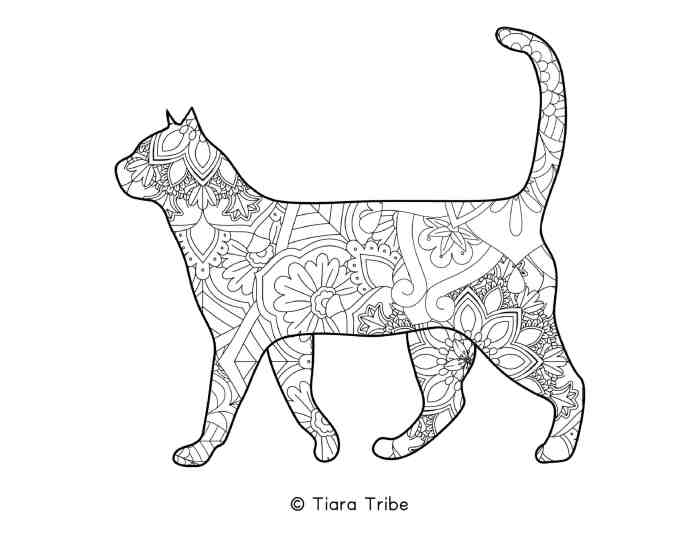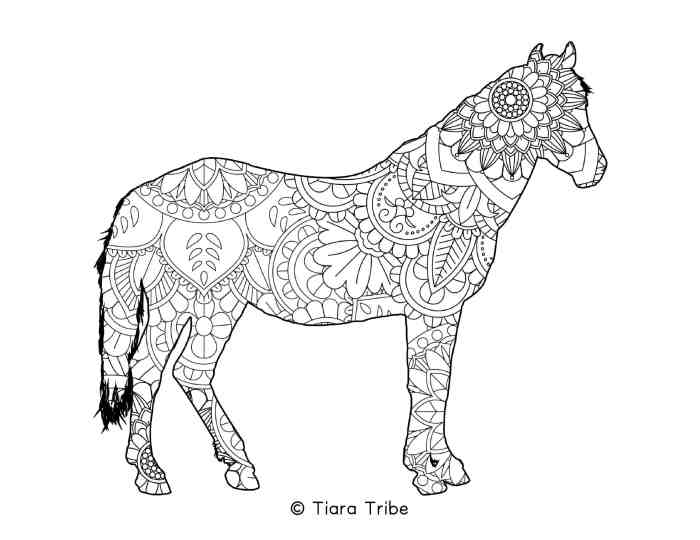Design Elements Analysis: Easy Mandala Animal Coloring Pages

Easy mandala animal coloring pages cater to a wide range of skill levels, from beginners to more experienced colorists. Their design is characterized by a balance between simplicity and visual appeal, making them engaging and accessible. The key design elements contribute significantly to this balance, influencing the overall aesthetic and difficulty level.The typical design elements found in these coloring pages revolve around the interplay of simplicity and detail within the mandala and animal motifs.
Line thickness is generally consistent throughout a given page, varying from thin and delicate lines suitable for fine-detail work to thicker lines providing more robust Artikels for easier coloring. Complexity ranges widely; simpler designs feature fewer intricate details and bolder Artikels, while more complex designs incorporate many fine lines, patterns, and overlapping shapes. Animal types are diverse, encompassing popular choices like cats, dogs, owls, butterflies, elephants, and mythical creatures like unicorns and dragons.
The integration of the animal form within the mandala structure itself is a crucial design element, with animals often forming the central focal point, or being incorporated as a key element within the overall symmetrical design.
Simple Versus Complex Mandala Animal Coloring Pages
Simple mandala animal coloring pages prioritize clear, bold Artikels and uncomplicated shapes. The animal representation is often simplified, focusing on key features rather than minute details. The mandala pattern itself is usually composed of repeating, easily recognizable shapes like circles, petals, or geometric patterns. This makes them ideal for younger children or beginners who are still developing their fine motor skills and coloring techniques.
In contrast, more complex designs showcase a higher level of detail, including intricate linework, numerous smaller shapes, and more elaborate patterns within the mandala and the animal depiction. The animals are more realistically rendered, with greater attention to anatomical details and textural elements. These designs challenge colorists with more complex shading and blending opportunities, allowing for greater creative expression.
For example, a simple design might feature a stylized cat head within a circular mandala with radiating petals, while a complex design could depict a realistic-looking tiger within a mandala featuring interwoven geometric shapes and intricate floral elements.
Color Palette Considerations
The color palettes used in mandala animal coloring pages are often vibrant and varied, reflecting the diverse nature of the animal subjects and the overall aesthetic. Popular choices frequently include warm earth tones for animals like lions or elephants (browns, oranges, yellows), cool blues and greens for aquatic creatures or birds, and bright, bold colors for more fantastical animals like unicorns or dragons.
Pastel shades are also a common choice, particularly for gentler animals and more delicate designs. The choice of color palette significantly impacts the overall mood and feeling of the finished artwork, with warm colors creating a sense of energy and vibrancy, while cooler colors convey calmness and serenity. The use of complementary or analogous color schemes can enhance the visual appeal, while contrasting colors can add dynamism and visual interest.
Easy mandala animal coloring pages offer a calming and creative activity, perfect for relaxation or mindful practice. For those seeking a wider variety of animal designs, you might also explore other resources like the extensive collection at dltk animals coloring pages , which offers a diverse range of styles. Returning to the intricate detail of mandala animal designs, these pages provide a unique blend of artistic expression and peaceful engagement.
Many designs leave the color choice entirely to the user, encouraging creative exploration and personal expression.
Content Creation and Presentation
This section details the creation and presentation of easy mandala animal coloring pages, focusing on a cat theme and offering variations in complexity. We will explore a sample design, present three design variations, and provide a beginner’s guide to creating similar pages.
Sample Cat Mandala Coloring Page Design
Our sample design features a stylized cat’s face as the central motif. The cat’s eyes are represented by two large, overlapping circles, each containing smaller, concentric circles for added detail. The nose is a simple triangle shape, also incorporating smaller circular patterns. The whiskers are depicted as flowing lines emanating from the nose, with smaller circles along their length.
The ears are rounded shapes with petal-like patterns within, creating a mandala-like effect. The overall design is symmetrical, reflecting the mandala style, with a balanced distribution of patterns and shapes. The line thickness is consistent throughout, maintaining an easy-to-color format. Negative space is strategically used to separate different elements and create visual interest, preventing the design from feeling cluttered.
The overall color palette is left open, allowing for creative expression.
Mandala Cat Coloring Page Design Variations
The following table presents three variations of the cat mandala design, progressing in complexity.
| Design 1: Simple | Design 2: Moderate | Design 3: Complex |
|---|---|---|
| This version features a simplified cat face with large, easily colored shapes. The eyes are large circles, the nose a simple triangle, and the ears are rounded shapes. Minimal internal detailing is present, focusing on clear Artikels and large spaces for coloring. | This design incorporates more intricate patterns within the basic cat features. The eyes might include radiating lines or small floral patterns. The nose could have added geometric shapes, and the ears could feature petal-like designs. The whiskers remain simple lines. | This complex design features highly detailed patterns within each element. The eyes could contain intricate geometric mandalas, the nose a complex arrangement of shapes, and the ears could be filled with elaborate floral or geometric designs. Additional decorative elements, such as paw prints or a tail, could be incorporated. |
How-to Guide: Creating Easy Mandala Animal Coloring Pages
This guide Artikels the steps involved in creating an easy mandala animal coloring page, suitable for beginners.
Step 1: Sketching the Basic Animal Shape
Illustration Description: A simple sketch of a cat’s face, with basic shapes for the head, eyes, nose, and ears. Lines are light and easily erasable. Focus is on capturing the overall form, not precise details.
Step 2: Adding Mandala Elements
Illustration Description: The basic cat shapes are now enhanced with simple mandala elements. Circles are added within the eyes, small triangles within the nose, and petal-like shapes within the ears. These elements are symmetrical and evenly spaced.
Step 3: Refining the Design
Illustration Description: The mandala elements are refined, adding more detail and complexity as desired. Lines are darkened and cleaned up, preparing the design for coloring. Symmetry is carefully checked.
Step 4: Finalizing and Coloring
Illustration Description: The final design is ready for coloring. The image shows a completed coloring page with vibrant colors, showcasing the finished mandala cat design. The image highlights the effectiveness of the design in terms of color application and overall visual appeal.
Educational and Therapeutic Aspects

Easy mandala animal coloring pages offer a unique blend of entertainment and learning, providing benefits that extend beyond simple artistic expression. These pages engage children in a creative process that simultaneously fosters cognitive development and emotional well-being. The simple, repetitive patterns inherent in mandalas promote focus and concentration, while the engaging animal themes add an element of fun and familiarity.The potential educational and therapeutic advantages of these coloring pages are multifaceted and can be harnessed in diverse educational settings.
Educational Benefits for Children
These coloring pages contribute to a child’s development in several key areas. Fine motor skills are honed through the precise movements required for coloring within the lines and filling in intricate details. Color recognition and understanding of color mixing are also enhanced as children experiment with different shades and combinations. Furthermore, the structured nature of the mandala designs can help children develop hand-eye coordination and improve their spatial reasoning abilities.
The act of completing a coloring page also fosters a sense of accomplishment and boosts self-esteem. Finally, the animal themes can spark curiosity and lead to further learning about different species and their habitats.
Therapeutic Benefits for Stress Reduction
Coloring mandalas is a recognized stress-reducing activity, offering a mindful escape for both children and adults. The repetitive nature of the patterns can help to quiet the mind and promote a sense of calm. The focus required for coloring allows individuals to momentarily disconnect from worries and anxieties, offering a form of meditative practice. The act of creating something beautiful can be intrinsically rewarding, boosting self-esteem and fostering a sense of accomplishment.
This is particularly beneficial for children who may be experiencing stress related to school, social situations, or other life events. The engaging animal themes add an element of playfulness that can further enhance the therapeutic effect.
Application in Educational Settings, Easy mandala animal coloring pages
Easy mandala animal coloring pages can be effectively integrated into various educational settings. In classrooms, they can be used as a calming activity during stressful periods or as a reward for good behavior. They can also be incorporated into lessons on animals, colors, or shapes, providing a hands-on learning experience. In therapy sessions, these coloring pages can be used as a tool for stress reduction, self-expression, and promoting relaxation techniques.
The therapist can use the activity as a starting point for conversations about emotions, self-esteem, or other relevant topics. Furthermore, the completed coloring pages can serve as a visual representation of the child’s progress and achievements, reinforcing positive self-image. For example, a child working through anxiety might find the repetitive patterns soothing, providing a tangible outlet for their emotions.
Similarly, a child struggling with fine motor skills could benefit from the practice and visual feedback provided by the coloring activity.
